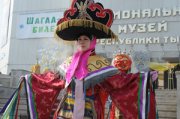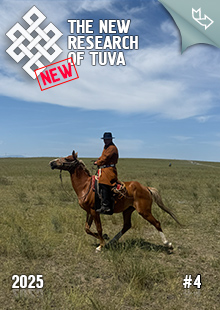 Why does the New Year in various countries have different names? Professor Nikolai Abayev has his own opinion about it.
Why does the New Year in various countries have different names? Professor Nikolai Abayev has his own opinion about it.
- It is necessary to realize that this holiday of the nomads originated long before the advent of Buddhism, - said the professor. - And the first herdsmen-nomads based their calendar on the realities of life. During many centuries, they attentively observed natural events and seasonal life cycles of various animals.
As a result of their observations, our ancestors determined, for example, that the fertility of various animal species cyclically increases. So, in the Year of the Hare, in correspondence with the 12-year and 60-year cycles, the fertility and the population of Hares sharply increases, but in the Year of the Bull (or Cow), the fertility of these animals grows, etc. so the Year of the Hare, Sheep, Horse, etc. showed up in the calendar of the nomads. And accordingly, people born in those years show the characteristics of these animals - the Masters or totems of those years.
There are themes in the folklore of Mongolian peoples dealing with the names of the years, specifically explaining why the 12-year cycle starts with the Year of the mouse. One day, as the legend states, the Buddha invited all the animals, whoever wanted to come, for his birthday. 12 animals came: it was cold, and to get to the Buddha, it was necessary to swim over a wide river. And as the animals showed up one by one, the Buddha gave each of them one year to rule. The first one to show up was the Rat, and received the first year of the 12-year cycle. True, the eyewitnesses of this remarkable swimming race insisted that the first one to reach the opposite shore was the Buffalo, but the Rat, who did not want to get soaked in the freezing water, asked the Buffalo to give him a ride on his back, and the Buffalo, in his good-hearted simplicity, agreed. As the Buffalo was shaking off the water, so that he could appear before the Buddha in a decent condition, the Rat jumped off of his back and quickly ran ahead, and in this way turned up at the head of the line. The Rat was rewarded for initiative and ability to use opportunities. Some of the spectators later swore that it was not the Rat but the tiny but clever Mouse, and that it did not ask permission to ride on the Buffalo's back, but went as a stowaway. The Buffalo never noticed the Mouse, and was astonished when he ended up second in the line.
Just a little bit after the Buffalo came the Tiger, who received the third year. The fans, who were cheering the race, distracted by the competition between the Buffalo and the Tiger (and since that time, in real life they always compete), did not watch very closely who came next - The Cat, the  Hare, or the Rabbit. Because it was so long ago, it is impossible to establish the truth, and that is how things remain in various eastern nations regarding the Master of the fourth year. The fifth was the Dragon, sixth the Snake, and the seventh - the Horse. Them a cloud of fog came over the river, and again it is not clear who came eighth - the Goat, the Sheep (or maybe the Ram). The Monkey showed up in the ninth place of the line. Are you surprised that the bright Monkey came so late? Well, he simply did not want to take any risks and watched carefully, observing the swimmers. He jumped into the water only after he became quite sure that the activity was safe... In the tenth place came the Rooster (but it could have been the Hen or Chicken, who can tell the difference when they are wet). He was delayed because he spent a long time pedantically instructing his large family as to what exactly they should be doing in his absence. Then, in the eleventh place, the Dog arrived. He had been working from the crack of dawn, finishing masses of household chores, and jumped into the water all heated up. It was said that he coughed for a long time afterwards. And all the way at the end, the Boar showed up (according to other sources he actually sent the Sow instead). He was not in much of a hurry: he is not ambitious, he is easy to please, and in life he usually picks up all the leftovers from the more pushy ones. The Buddha gave him the last remaining year.
Hare, or the Rabbit. Because it was so long ago, it is impossible to establish the truth, and that is how things remain in various eastern nations regarding the Master of the fourth year. The fifth was the Dragon, sixth the Snake, and the seventh - the Horse. Them a cloud of fog came over the river, and again it is not clear who came eighth - the Goat, the Sheep (or maybe the Ram). The Monkey showed up in the ninth place of the line. Are you surprised that the bright Monkey came so late? Well, he simply did not want to take any risks and watched carefully, observing the swimmers. He jumped into the water only after he became quite sure that the activity was safe... In the tenth place came the Rooster (but it could have been the Hen or Chicken, who can tell the difference when they are wet). He was delayed because he spent a long time pedantically instructing his large family as to what exactly they should be doing in his absence. Then, in the eleventh place, the Dog arrived. He had been working from the crack of dawn, finishing masses of household chores, and jumped into the water all heated up. It was said that he coughed for a long time afterwards. And all the way at the end, the Boar showed up (according to other sources he actually sent the Sow instead). He was not in much of a hurry: he is not ambitious, he is easy to please, and in life he usually picks up all the leftovers from the more pushy ones. The Buddha gave him the last remaining year.
- In a word, the New Year's celebration of the nations of eastern and Central Asia is a complicated phenomenon, a product of prolonged historical evolution of various calendar systems, - continues Abayev. - It is difficult to overestimate their importance.
 According to our nomadic ideas, the White Moon personifies such very festive and solemn feelings as renewal of life, purity of intentions, good will, hospitality, joy of being with others - as a matter of fact, non-alcoholic joy. The main beverage is milk with tea. This ancient holiday combines religious and ethical values, the life philosophy of our ancestors, their high moral and spiritual values, and traditions of national culture.
According to our nomadic ideas, the White Moon personifies such very festive and solemn feelings as renewal of life, purity of intentions, good will, hospitality, joy of being with others - as a matter of fact, non-alcoholic joy. The main beverage is milk with tea. This ancient holiday combines religious and ethical values, the life philosophy of our ancestors, their high moral and spiritual values, and traditions of national culture.
And we, their descendants, have to simply follow those traditions, without paying attention to petty differences in the names of the animals, and also the unimportant differences in the calculations of the concrete dates by astrologists of various nations; in short, we have to show tolerance. The main thing is that with the New Year, a new cycle of life begins for each of us.

